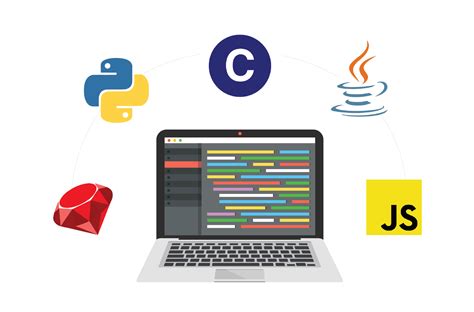Title: Beginner's Guide to Big Data Programming Languages
In today's datadriven world, big data has become a critical asset for businesses and organizations across various industries. To harness the power of big data effectively, it's essential to master the programming languages commonly used in this field. In this beginner's guide, we'll explore the key programming languages for big data and provide insights into their features, applications, and learning resources.
1. Python
Overview:
Python has emerged as one of the most popular programming languages for big data analytics due to its simplicity, versatility, and rich ecosystem of libraries.
Features:
Easy to Learn:
Python's clean and readable syntax makes it accessible for beginners.
Abundant Libraries:
Libraries like Pandas, NumPy, and Matplotlib offer robust support for data manipulation, analysis, and visualization.
Scalability:
Python frameworks like PySpark enable seamless integration with big data processing systems like Apache Spark.
Community Support:
Python boasts a large and active community, ensuring ample learning resources and support.
Applications:
Python is widely used for data preprocessing, exploratory data analysis, machine learning, and building datadriven applications.
Learning Resources:
Online Courses:
Platforms like Coursera, Udemy, and edX offer numerous courses on Python for data science and big data analytics.
Books:
"Python for Data Analysis" by Wes McKinney and "Python Data Science Handbook" by Jake VanderPlas are highly recommended resources.
Documentation and Tutorials:
The official Python documentation and websites like DataCamp and Towards Data Science provide comprehensive tutorials and guides.
2. R
Overview:
R is a powerful programming language specifically designed for statistical computing and data analysis.
Features:
Statistical Analysis:
R excels in statistical modeling, hypothesis testing, and advanced data visualization.
Extensive Packages:
The Comprehensive R Archive Network (CRAN) hosts thousands of packages for diverse analytical tasks.
Data Manipulation:
Packages like dplyr and tidyr facilitate efficient data wrangling and manipulation.
Graphics:
R's ggplot2 package offers elegant and customizable data visualization capabilities.
Applications:
R is commonly used in academic research, data exploration, and statistical modeling.
Learning Resources:
Online Courses:
Platforms like Coursera and DataCamp offer comprehensive courses on R programming and data analysis.
Books:
"R for Data Science" by Hadley Wickham and Garrett Grolemund is a popular resource for beginners.
Community Forums:
Websites like Stack Overflow and Rbloggers provide valuable insights and solutions to common challenges.
3. SQL (Structured Query Language)
Overview:
SQL is the standard language for managing and querying relational databases, which are prevalent in many big data applications.
Features:
Data Querying:
SQL enables users to retrieve, manipulate, and analyze data stored in relational database management systems (RDBMS).
Scalability:
SQL is designed to handle large volumes of structured data efficiently.
Data Integrity:
SQL ensures data consistency, integrity, and security through its transactional capabilities.
Standardized Language:
SQL's standardized syntax ensures portability across different database platforms.
Applications:
SQL is essential for data warehousing, database management, and adhoc querying in big data environments.
Learning Resources:
Online Courses:
Platforms like Udemy, Codecademy, and Khan Academy offer courses on SQL fundamentals and advanced topics.
Interactive Tutorials:
Websites like SQLZoo and Mode Analytics provide interactive SQL tutorials for handson learning.
Certification Programs:
Certifications like Oracle Certified Associate (OCA) and Microsoft Certified: Azure Data Fundamentals validate proficiency in SQL.
4. Scala
Overview:
Scala is a powerful programming language that combines objectoriented and functional programming paradigms, ideal for building scalable and resilient big data applications.

Features:
Interoperability:
Scala seamlessly integrates with Java and is the primary language for Apache Spark, a popular big data processing framework.
Concurrency:
Scala's actorbased concurrency model facilitates parallel and distributed computing, essential for handling large datasets.
Functional Programming:
Scala's functional features promote concise and expressive code, enhancing developer productivity.
Type Safety:
Scala's static typing system ensures code reliability and prevents common runtime errors.
Applications:
Scala is widely used for developing data pipelines, distributed systems, and realtime analytics applications.
Learning Resources:
Online Courses:
Platforms like Coursera and Udemy offer courses on Scala programming and functional programming concepts.
Books:
"Programming in Scala" by Martin Odersky, Lex Spoon, and Bill Venners is a comprehensive resource for learning Scala.
Official Documentation:
The Scala website provides extensive documentation, tutorials, and guides for beginners and experienced developers.
Conclusion:
Mastering programming languages for big data is essential for anyone aspiring to excel in data analytics, machine learning, and datadriven decisionmaking. Whether you're a beginner or an experienced professional, investing time in learning Python, R, SQL, and Scala will undoubtedly enhance your capabilities and open doors to exciting career opportunities in the field of big data. Remember to leverage online courses, books, documentation, and community forums to accelerate your learning journey. Happy coding!
